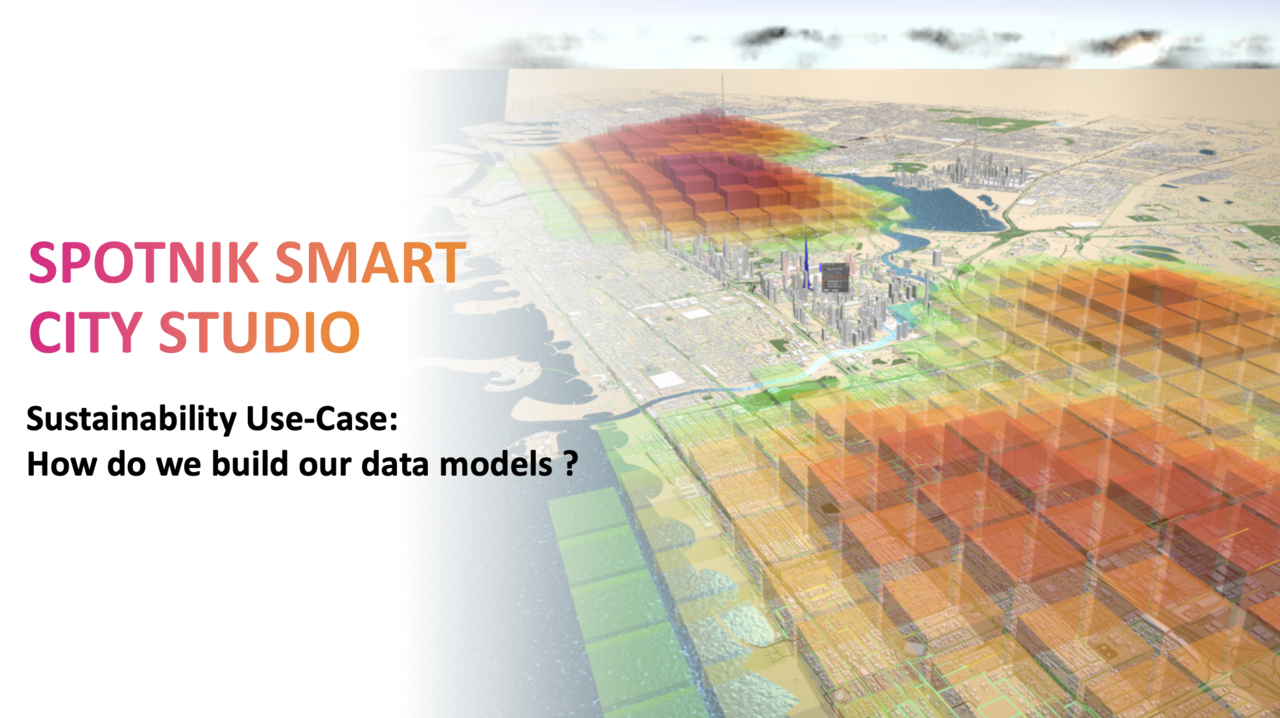SPOTNIK SMART CITY STUDIO — Sustainability Use Case: How Do We Build Our Data Models?
Sustainability is one of the keystones in driving new value and growth in the development of new cities to address global goals on climate change.
Spotnik Technologies, a Nikai Group company based in U.A.E, strongly supports the initiative by developing productivity and efficiency software solutions for Smart Cities. Initially, we offer an urban Digital Twin considering data related to Sustainability, but the tool can be applied to any other Smart City domain.
The company’s clear objective is to deliver valuable insights, facilitating visual reporting, and simulations for better planning and forecasting.
To achieve this, Spotnik developed a data management framework and logical models for AI data simulations from city-wide open data, related to sustainability.
The company built a module that uses geo-localized data over a GIS-enabled 3D Game Engine. In the backend, an automated client-side service is running for fetching historical and live data streams from various sources. These data sets include but are not limited to, geographical data, contextual information, and semantics via varying standard data formats such as JSON and XML.
Once the data preparation process is achieved, the data pass through proprietary implemented algorithms and empowered 3D Engine physical and environmental simulation capabilities. This enables an effective way to simulate city-wide data according to a well-defined, multi-step process. The last step is to visualize and project actionable, value-driven sustainability insights in a 3D environment.
To assist the engineering efforts, Spotnik team of consultants, designers, and engineers, established research and studies related to sustainability data. The team analyzed open data and formulations – from which these interpretations were based on various research from reputed publications from international universities, public research centers, and NGOs. This aims to quantify and understand the key factors inducing CO2 emissions at a district-scale/city-scale (traffic, housing, weather, and so on).
Based on the study, the company developed a business logic workflow and data models that enable answering interrogations such as: Can we assess when/where/how much CO2 is emitted over a city? How can we build a CO2 emissions budget map of a city? What is the financial impact on a city, a district, or a community? What is the Carbon offset required to reduce the sustainability bill?
Our models involve all the factors contributing directly, or indirectly to Carbon emissions and enable the most accurate estimations of CO2 emissions’ financial impact, and carbon offset induced. These factors include:
– Traffic: Traffic density, jam factor, vehicle consumption, average speed per section…
– Time: Hour, day/night, months, season
– Energy consumption: electricity consumption, building type (residential, commercial, industrial)
– Weather: temperature, humidity
– Population density
– Public lighting
Once the Carbon Dioxide budget is calculated for a whole city with different granularities (city/district/building), the KPIs of the financial impact and carbon offset are deducted by applying approved formulas and algorithms.
Example of CO2 emissions equivalent to a barrel of oil consumed:
According to the US Environment Protection Agency (EPA https://www.epa.gov/ ), the Carbon Dioxide emissions per barrel of crude oil are determined by multiplying heat content times the Carbon coefficient times the fraction oxidized times the ratio of the molecular weight of Carbon Dioxide to that of Carbon:
5.80 mmbtu/barrel × 20.31 kg C/mmbtu × 44 kg CO2/12 kg C × 1 metric ton/1,000 kg = 0.43 metric tons CO2/Oil Barrel
Example of Carbon offset calculation with an equivalent Number of urban tree seedlings grown for 10 years:
According to the United States Department of Agriculture (https://www.fs.usda.gov/psw/publications/documents/psw_gtr253/psw_gtr_253.pdf), a medium-growth coniferous or deciduous tree, planted in an urban setting and allowed to grow for 10 years, sequesters about 38.0 lbs of Carbon, which lead to the following value of 0.060 metric ton CO2 per urban tree planted.
These estimates are based on the following assumptions (detailed in the link above).
Below is an example of high-level data logic interpretation implemented in the Spotnik City twin platform:

We are involved in a continuous improvement process and are open to collaborate with subject matter experts, consulting firms, and sustainability analysts, to improve our models and deploy project samples over new or existing urban developments to test our Smart City Studio as the ultimate reporting and simulation utility.







